Many people will tell you that to be healthy, you have to cancel certain foods.
The offending edibles: Those brightly-packaged, cartoon-endorsed, highly-refined, ultra-delicious foods often found in center aisles of the grocery store.
According to popular opinion, these “junk foods” come with lots of calories, but hardly any of the stuff the human body needs for good health.
And yet:
This isn’t a “don’t eat these terrible foods” story.
That’s because…
- Delicious food serves a purpose, even if it contains little to no nutritional value.
- Low-quality foods can actually be good for you.
- 100 percent abstinence isn’t necessary (and usually backfires).
Those statements might seem controversial. That’s why we’re going to back them up—using what we’ve learned from coaching over 100,000 clients, and some fun charts.
Plus, we’ll reveal a 5-step process that can help you savor the foods you love, without guilt—and without harming your health.
First, a disclaimer.
We don’t like the phrase “junk food.”
Junk food isn’t garbage.
As you’ll see below, foods can offer near-zero nutritional value and still improve some aspects of overall health.
Plus, referring to food as “junk” creates a “good food” vs. “bad food” dichotomy that does more harm than good. (Read more: We’ve Told 100,00 Clients That There Are No Bad Foods)
We use the phrase “junk food” simply because that’s how people talk in real life.
Our use of this phrase doesn’t mean we think these foods are bad, wrong, or worthless. They’re anything but.
Let’s find out why.
Three good reasons to embrace junk food
Although there are exceptions out there—the people who actually prefer carrots sticks to BBQ chips—the vast majority of us delight in the ultra-flavorful, often neon-colored world of processed foods.
This article isn’t for the carrot-eaters. (Y’all are doing awesome. You’re freaks, but you’re awesome—and don’t need to change a thing.)
This article is for the majority, who love these foods but also often experience an internal conflict around them: On the one hand, they taste SO good; on the other hand, you don’t want to ruin your health.
Our pitch: If you love junk food, you CAN include it in your diet, without feeling guilty or worrying that it’ll ruin your health.
We’ve got three reasons why.
Over 150,000 health & fitness professionals certified
Save up to 30% on the industry's top nutrition education program
Get a deeper understanding of nutrition, the authority to coach it, and the ability to turn that knowledge into a thriving coaching practice.
Reason #1: You’ll likely eat junk food anyway.
If you’ve ever said, “That’s it. I’m never eating this stuff again!” you probably assumed your future would look something like the Zero-Junk Fantasy.
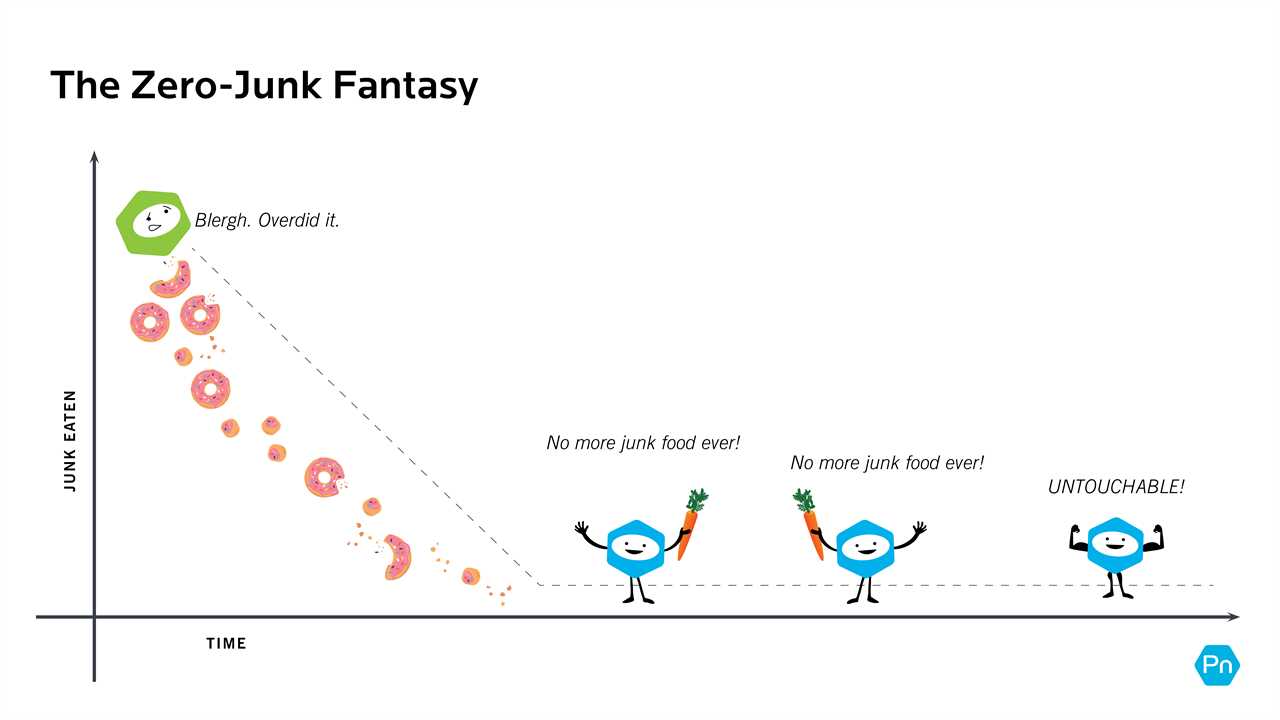
In reality, aiming for 100 percent self-restraint often goes more like the “Screw It” Cycle below.
You say you’ll never again eat donuts with pink frosting. Then you eat one. That leads to, “Screw it! Give me all the donuts!” At some point (perhaps January 1, or any given Monday) you try again with a new declaration of abstinence, and the cycle continues.
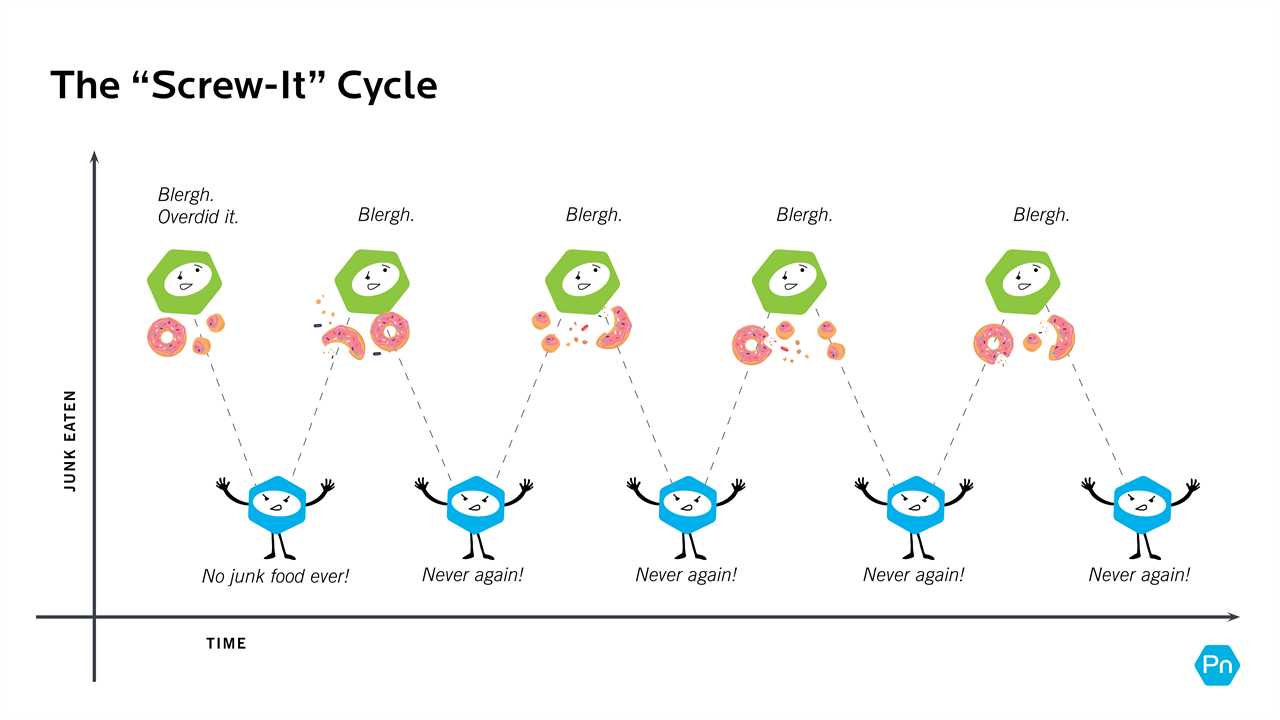
Imagine how things might change if you ate half a pink-frosted donut on a regular basis, and didn’t feel guilty about it. In other words, you welcomed a little bliss into your life, every day.
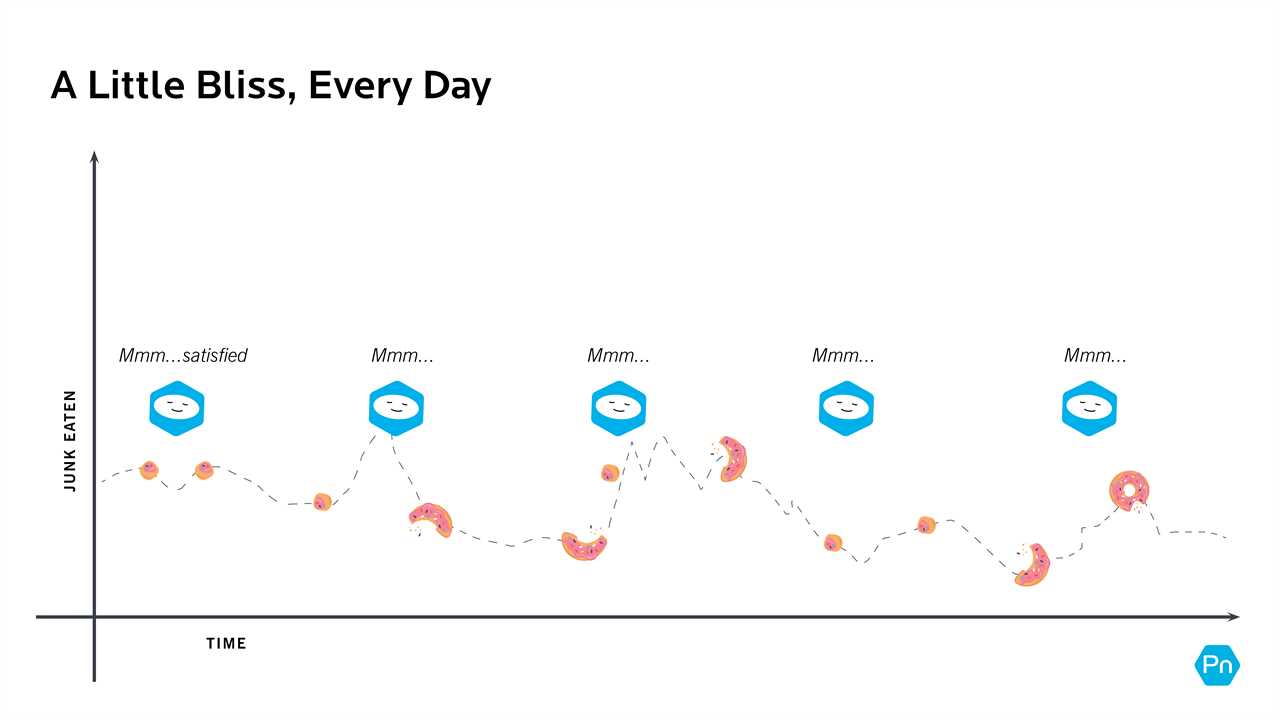
As you can see, when you eat your favorite foods regularly and intentionally, you’ll likely consume less of them than when you eat a lot, then none, then a lot, then none. (Plus, you’ll feel a lot less spun out and defeated.)
For most people, including a bit of what you love regularly actually helps to curb cravings and feel more satisfied.
However, you know yourself best.
If a certain food makes you feel totally out-of-control—you have trouble managing your portion, or feel mentally and/or emotionally “checked out” while eating it—sometimes it’s easier to abstain from it completely, at least for a period of time.
(If your eating behaviors often feel compulsive and hard-to-control, check out: Food addiction: Why it happens, and 3 ways to get help)
Reason #2: Junk food won’t stop you from progressing toward your health goals.
You don’t need to eat perfectly 100 percent of the time to make progress.
(In fact, aiming for perfection usually backfires because of Reason #1.)
From coaching over 100,000 clients, we’ve learned that while there’s no “magic” percentage, generally all you need to improve health, athletic performance, and body composition is to:
Eat a diet composed of about 70 to 80 percent nutrient-dense minimally-processed foods.
And that’s your end goal.
(If that guideline sounds unrealistic, you can improve your health by just slightly tipping the ratio toward more minimally-processed foods—wherever you’re starting from.)
Even if you’re trying to become your healthiest and fittest ever, you never have to aim for 100 percent “virtuous” (a.k.a. no treats ever).
That’s because as food restriction goes up, so can other problems such as food obsession, anxiety, and disordered eating.
For a visual, check out the graphic below.
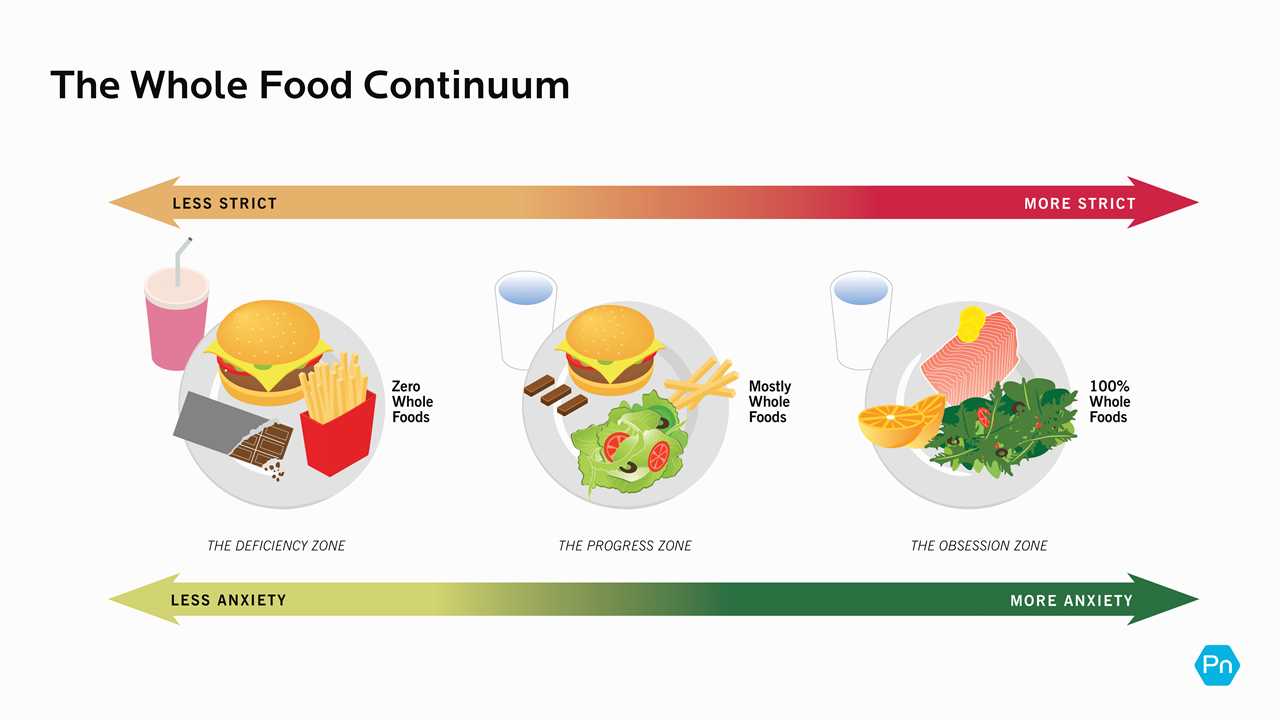
Due to the steep costs, we only recommend highly restrictive diets for clients who are prepared for the tradeoffs.
These people—the pro athletes, physique competitors, and celebrities among us—often earn their living based on how their bodies look and perform. (And also tend to be surrounded by people who help them make it all happen.)
Even so, our pro clients only occasionally reach the 90 to 99 percent mark—and often only during the time leading up to a competition, event, or role.
Then they shift to a more sustainable approach.
(Want proof that perfection isn’t required to progress? Read: Nearly 1 million data points show what it really takes to lose fat)
Reason #3: Reasonable amounts of junk food can boost health.
It’s true that consuming high amounts of low-quality foods likely worsens your physical health.
However:
Your physical health only makes up a part of your overall health.
As the graphic below shows, your relationships, sense of meaning and purpose, mental clarity, emotional wellbeing, and surrounding environment round it out.
At PN, we refer to these intersecting aspects of wellbeing as deep health. While certain foods in certain amounts likely harm some aspects of deep health, they may actually improve others.
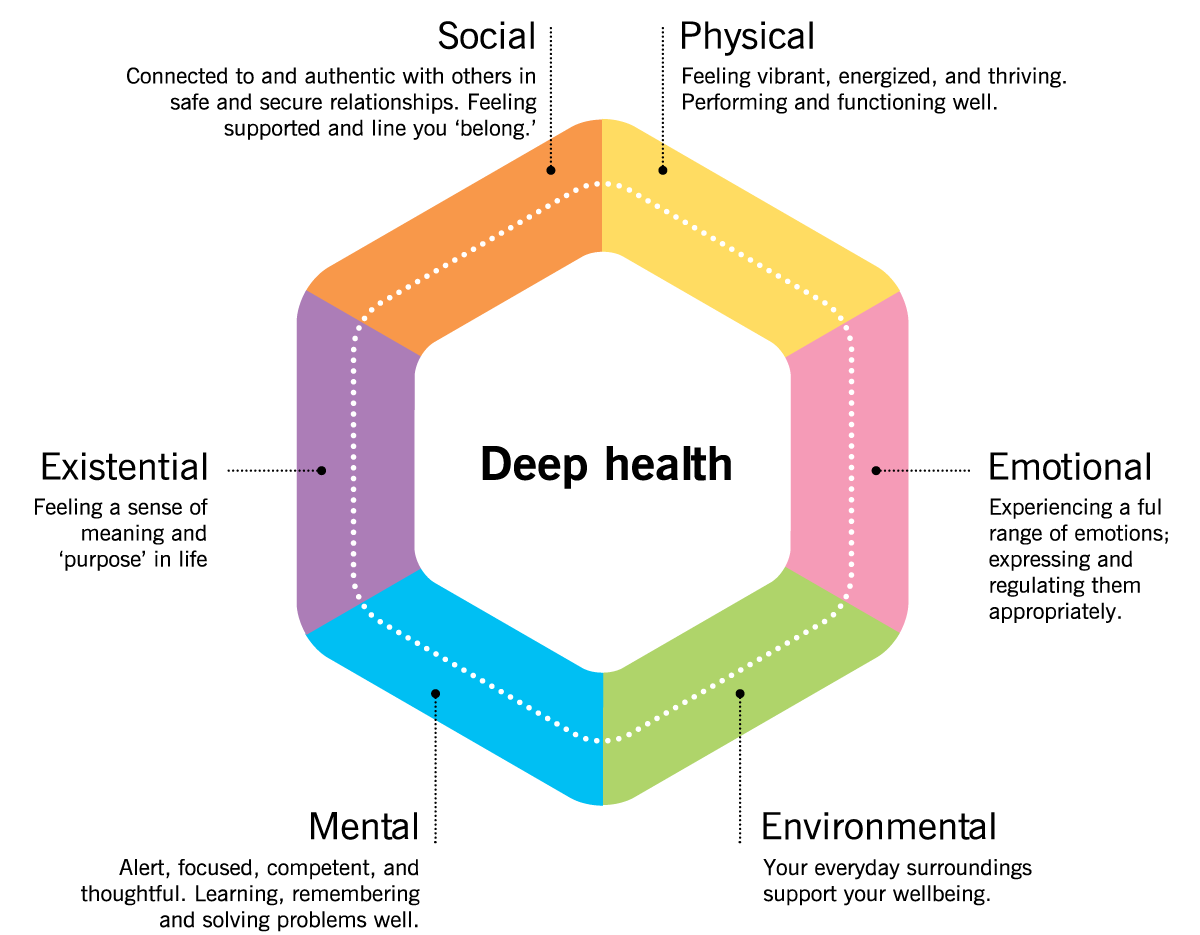
(If this is confusing, we promise it’ll make more sense in about 30 seconds.)
To understand how this works:
Think of the deep health dimensions as a battery pack.
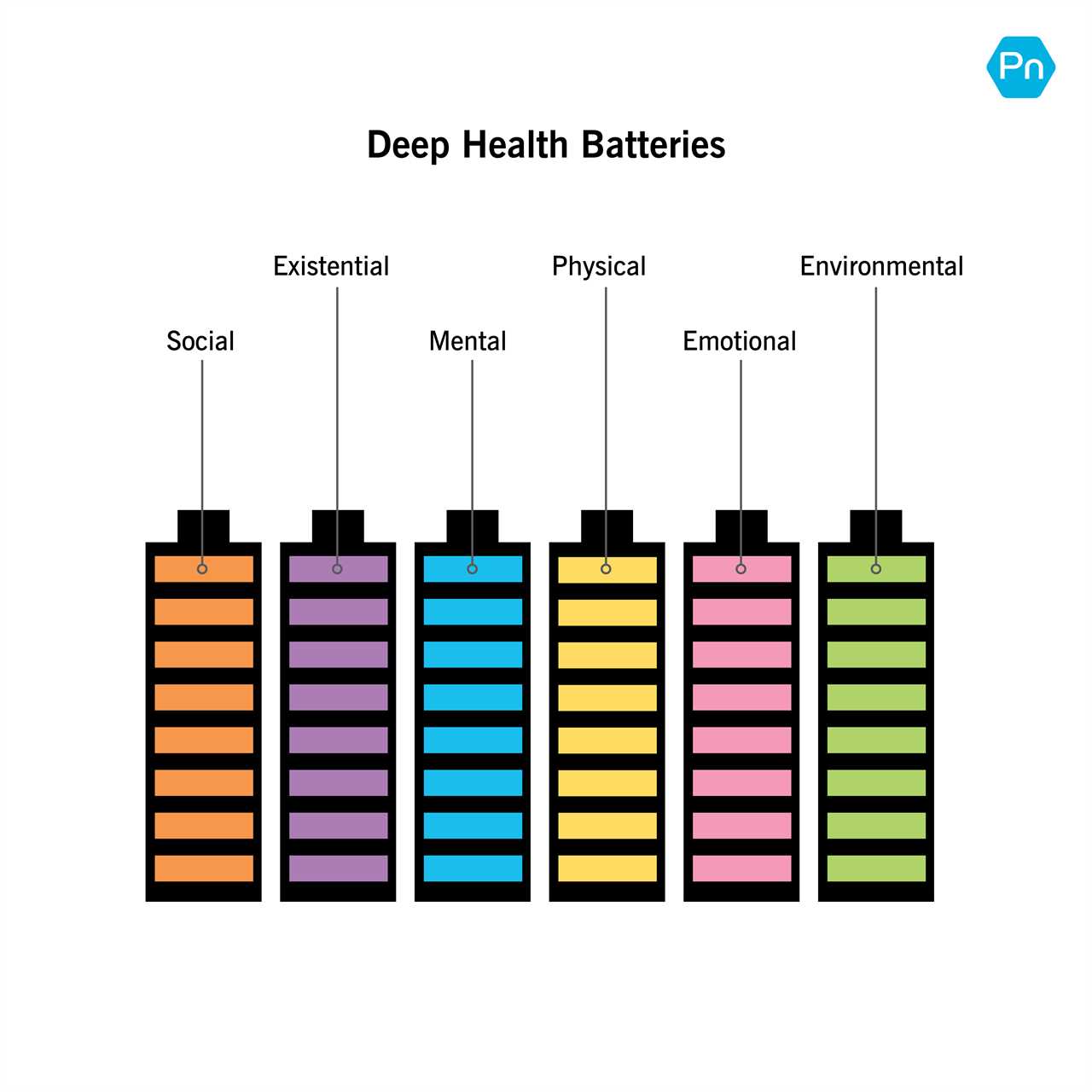

Some choices and experiences charge some batteries; others drain them.

If you charge more than you drain, you feel great.

If you drain more than you charge, problems happen. Maybe you develop a health issue, struggle to get out of bed, or just feel kind of “blah.”
Too much junk food over time can drain your physical health battery.
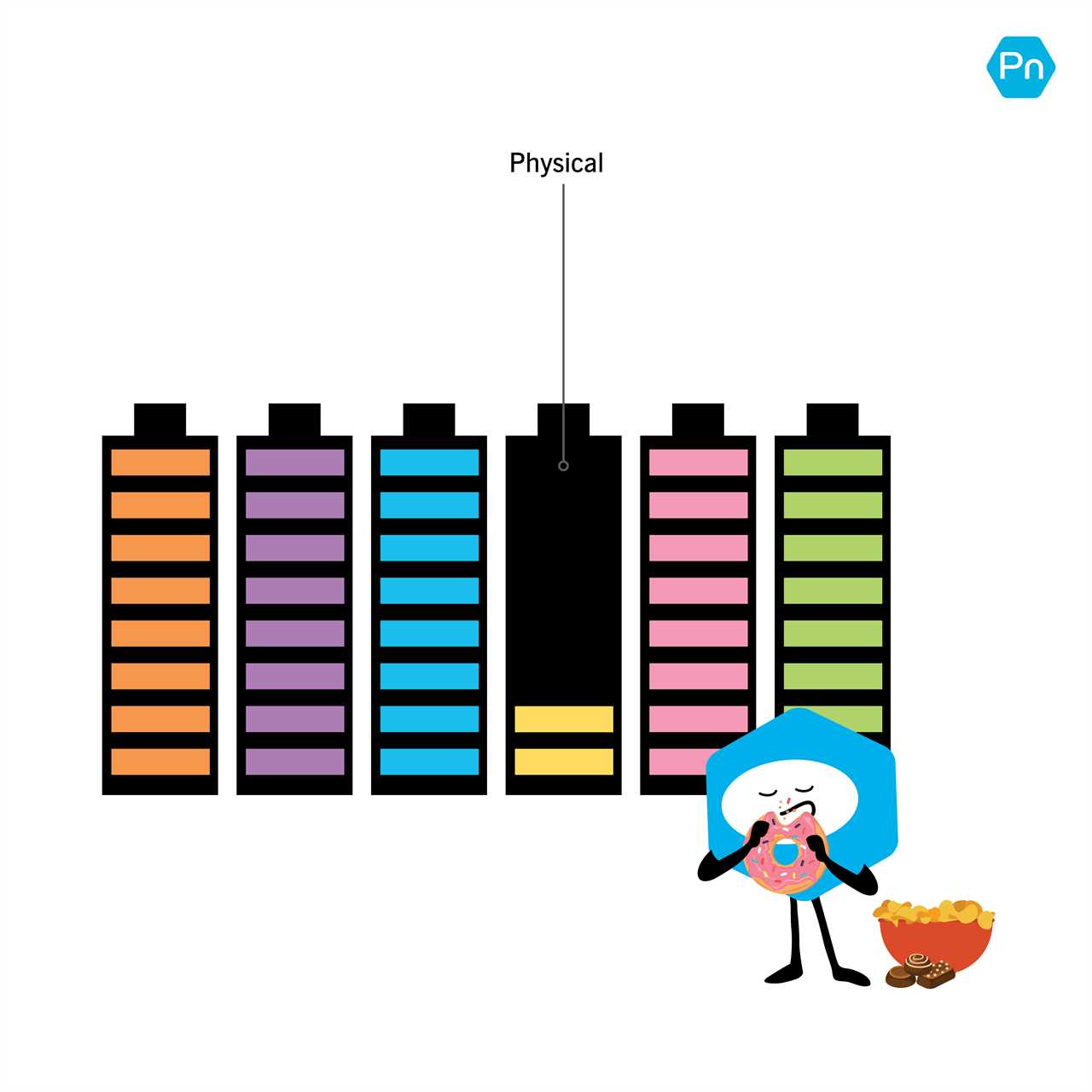
Depending on how much you consume, low quality foods might also bring on brain fog and sluggishness, draining your mental battery. And this often leads to feelings of guilt, shame, and frustration, draining your emotional battery too.
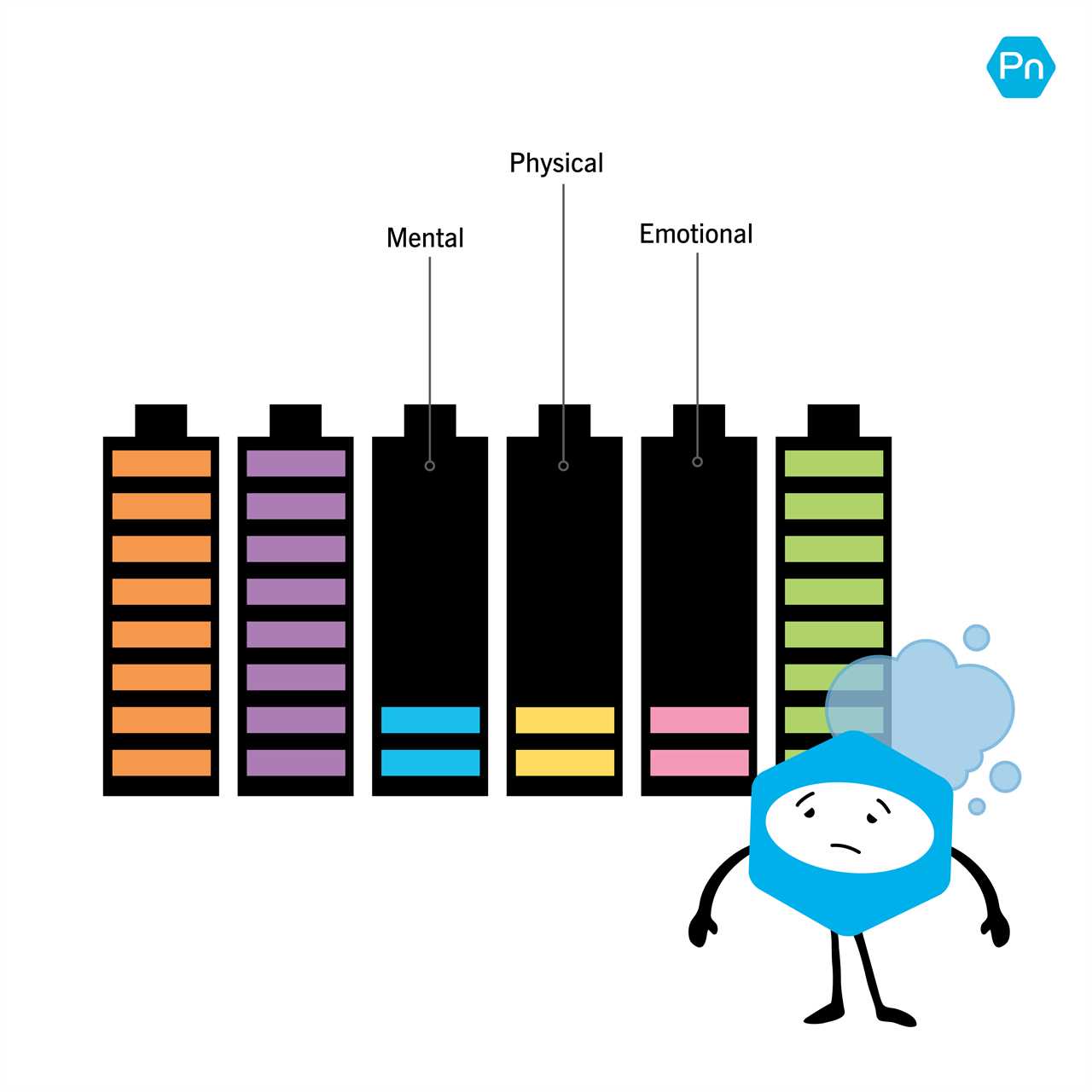
HOWEVER… if you move regularly, sleep well, manage your stress, and center the majority of your diet around lean proteins, veggies, fruits and other minimally-processed carbs, and healthy fats, you can keep those physical, mental, and emotional health batteries pretty well powered up.

You can help minimize the negative effects of junk food by maintaining overall good health habits.
But here’s something most people miss: Junk food can actually charge other batteries—assuming you consume it intentionally.
By intentionally, we mean:
You choose to eat the food on purpose (not just because it’s there), with joy and contentment (rather than guilt), in an amount that aligns with your overall health goals, and after weighing and accepting the tradeoffs.
Do all of that and you might see an increase in…

Social health if you consume the food with a friend or loved one

Existential health if that yumminess alights your soul with pleasure—and doesn’t make you feel guilty (cookie dough for the soul, anyone?)

Emotional health if small, intentional indulging helps you feel content, relaxed, and satisfied (rather than deprived and, eventually, resentful)
The result: that ice cream excursion may actually boost overall health (even if it doesn’t directly benefit physical health).

Want to ensure your favorite foods power your health batteries more than they drain them? Use this 5-step process.
Step 1: Decide whether the benefits are worth the tradeoffs.
Think about your favorite treats—and how they affect your deep health.
Then ask yourself:
Is this food worth it?
It might not be if, in addition to draining your physical health, the food also drains your:
- Emotional health (because you feel ashamed and guilty)
- Social health (because that shame causes you to retreat to a lonely parking lot or hidden corner of your house to eat)
On the other hand, the food might absolutely be worth it if it adds meaning to your life, is part of a social ritual, and/or helps you cope with stress (along with other adaptive coping skills and strategies).
Only you can decide.
After thinking about the pros and cons, make an intentional choice to either include the food (or not).
Step 2: Notice and name any negativity.
Let’s say you’ve decided to include those crunchy, cheezy snacks in your dietary repertoire.
Then you hear it: A voice in your head bellowing, ‘NOOOOO! DON’T TOUCH THE ORANGE DUST! BAAAD!’
And yet, two minutes after you’ve scolded yourself like a disobedient puppy, you’re up to your forearms in a fine layer of sticky orange powder.
Despite its insistence, that judging, bellowing voice isn’t so effective.
Instead of scaring us into doing the right thing, that voice usually just provokes us to do the opposite:
Eat more.
Why?
Well, for one, no one likes being told “No.”
A big, scary, finger-wagging “NO” causes your inner teenager to rebel and eat the whole bag instead.
Or, it causes you to feel so ashamed that you shove a bunch of food in your mouth for comfort—often in secret away from the judgment of others.
To work with this voice and the feelings it provokes, try a simple technique called “notice and name.”
How to do it
Noticing means paying attention to your thoughts, feelings, and actions.
Consider:
- What are you doing… right now?
- What are you thinking… right now?
- What’s around you… right now?
Naming means you describe the situation to yourself.
When you notice and name negative thoughts about your food choices, it might sound like this:
“I hear the ‘this is bad’ voice in my head right now. Noticing that. I’m also feeling kind of ashamed and in a rush to eat the whole thing and get it over with.”
Awareness gives you time to respond.
From there, you can consciously decide what to do next.
Maybe you crunch away anyway.
Or maybe you just sit with the voice, and see if anything changes.
For example, if you sit with it long enough, that voice that initially seemed so angry might shift into a voice that’s more scared and concerned:
“I’m just afraid that if you eat too much, you’ll get some terrible disease.”
If you sit with it further, that voice may reveal a deep sense of self-love and care:
“All I really want is for you to be happy and healthy. I’m just looking out for you.”
And that’s a much easier feeling to work with.
Step 3: Set up guardrails.
Impulsive eating often goes something like this:
“Ooooh, Sally brought homemade brownies!”
[Cue zombie-like binge]
Chances are, you walk away from that sort of experience with a yucky feeling—and crumbs on your face.
Guardrails can help you navigate tempting opportunities with some control, so you can rein in those impulsive experiences.
To set them up, use a framework we teach our clients. It’s called the 3S framework—S stands for systems, structures, and schedules.
(We know that sounds about as exciting as a trip to a paper clip factory, but trust us, this is a golden framework that can make any goal more achievable. Stick with us.)
Design a junk food system
Systems are practices and rituals that help align your actions with your intentions and goals.
To set up a system to make intentional eating easier, you might ask yourself:
What will make it easier to eat intentionally—and harder to eat impulsively?
Maybe you…
- Do a weekly grocery run and/or weekly meal prep to have healthy foods accessible and ready-to-eat.
- Buy family size bags of snacks, then re-portion them into individual serving containers. Or, only buy pre-portioned snack sizes of these foods (e.g. 100-calorie snack packs).
- Consume your favorite low-quality foods after your largest meal, so you’re less likely to overeat those foods from sheer hunger.
Add some structure
Structures are the environments that contain us, and shape our habits. They include our homes, workplaces, and other places we go.
To create an environment that supports mindful eating, ask yourself:
What needs to be around me to help me eat with intention?
Maybe you decide to:
- Stock your kitchen with healthy food that you like, is easy to eat, and is visible. For example, fresh fruit in a basket on the counter.
- Turn your home into a “safe zone” (with limited tempting foods) so you don’t succumb to impulsive eating when you’re having a bad day. (And keep those tempting foods out of sight.)
- Take the long route to the bathroom at work, both to get in more steps as well as to avoid seeing a coworker’s candy bowl.
Schedule it
Schedules create a time-specific “container” for certain behaviors, so they don’t bleed into your life 24/7.
To help make junk food more intentional, ask yourself:
When can I schedule indulgent snacking so that I enjoy it but also feel less guilty and anxious?
Maybe you decide to…
- Create a flexible weekly meal plan that includes a base of healthy meals, plus intentional pleasures—a fun size candy bar after lunch or a small bowl of ice cream after dinner.
- Schedule your snack for the same time every day, such as a 3 pm luxurious work break, with a few squares of chocolate, a cup of decaf, and zero distractions.
- Organize a weekly or bi-weekly evening with your friends, complete with chips and booze—netting a social and existential health boost.
The small changes above can help you eat junk food without feeling deprived or restricted. You’ll be able to consume it because you want to, and not because it’s just there.
Step 4: Enjoy it.
This might seem like a no-brainer, but we’ll say it anyway:
If you’re going to choose to have something delicious, you might as well…
Savor the experience.
In addition to increasing enjoyment, savoring can also help you feel more satisfied with a smaller amount. To do it:

Pay attention to the experience of eating. Consume treats in a setting that allows you to enjoy every bite. So…
- Step away from your computer, TV, or phone.
- Take a few deep, slow breaths before the first bite, to calm distracting thoughts and anxiety.
- Use your senses—sight, smell, taste, touch—to fully enjoy it.

Eat slowly. That makes the deliciousness last longer, and also helps you to feel calmer. (See why this practice is the bomb: The 30-day slow eating challenge that can transform your body)

Swap guilt for pleasure. Use the notice and name technique to uproot any guilty thoughts. After bringing awareness to any negative feelings, shift your focus to your senses again, and how goooood this tastes.
“My portion is gone—and I’m bummed!”
Thanks to a combination of out-of-this-world flavor and brain-altering chemicals, certain foods are super hard to stop eating.
Like a 3-½ minute massage, they leave your brain begging for more.
We’ve already told you about a few things that can help.
But sometimes, those practices aren’t enough.
Even after mindfully eating an intentional portion, you might still feel like a toddler tantruming: “More! More!! MORE!!”
Or maybe other painful feelings come up: sadness, emptiness, anxiety, even anger.
The tough news: Sometimes you can’t avoid these feelings, and you just need to sit with your discomfort.
As you surf these uncomfortable sensations, try using self-talk that’s compassionate, rational, and kind:
“Wow, my brain REALLY wants more right now. This food is delicious, but if I eat more it WON’T keep boosting my existential health—and it might drain my physical, mental, and emotional health. This feels hard and uncomfortable, but I’ve reached the point where this food can no longer nourish me and I’m choosing to stop.”
In addition to speaking to yourself kindly, you might also take a kind action: Turn on your favorite music, make some tea and get cozy on the couch with a book, or whatever helps you feel nourished and cared for.
(Why are some foods SO hard to stop eating? Read: Manufactured deliciousness and overeating)
Step 5: When you mess up, move on.
The truth is:
On occasion, you’re going to eat impulsively.
We ALL do this sometimes. (Erm… including everyone who wrote and edited this piece.)
When you catch yourself mindlessly inserting things in your mouth, call it out, and do a little detective work to explore what’s going on.
Ask yourself…
- What led to this moment?
- Has this ever happened before? When?
- What might I do differently in the future?
(Psst: Our Break the Chain worksheet can help you with the above sleuthing, especially if a behavior is a persistent problem.)
Once you’ve gained some insights, wipe the slate clean.
What you just ate a few moments ago no longer matters. It’s over, and no amount of negativity is going to undo it. Learn from it, and move forward.
Take a positive step in any dimension of health: Go for a walk (physical health), snuggle your pet (emotional and social health), relax in a beautiful, awe-inducing setting (existential health), or write about what happened in your journal (mental and emotional health).
We all deserve pleasure.
Trying to be too perfect often leads to diminishing returns.
So, instead of denying—or demonizing—junk food, approach it like you would that wild friend you had in college.
You might not want to live the party life 24/7, but darn, it sure is fun in small, regular doses.
If you’re a coach, or you want to be…
Learning how to coach clients, patients, friends, or family members through healthy eating and lifestyle changes—in a way that’s personalized for their unique body, preferences, and circumstances—is both an art and a science.
If you’d like to learn more about both, consider the Precision Nutrition Level 1 Certification.
The post How to eat junk food: A guide for conflicted humans appeared first on Precision Nutrition.
-----------------------------------------
By: Brian St. Pierre, MS, RD
Title: How to eat junk food: A guide for conflicted humans
Sourced From: www.precisionnutrition.com/how-to-eat-junk-food
Published Date: Fri, 14 Jan 2022 17:30:53 +0000
Read More
 General Health and WellnessFitness and ExerciseSupplements and VitaminsPandemic NewsVideosPrivacy PolicyTerms And Conditions
General Health and WellnessFitness and ExerciseSupplements and VitaminsPandemic NewsVideosPrivacy PolicyTerms And Conditions
